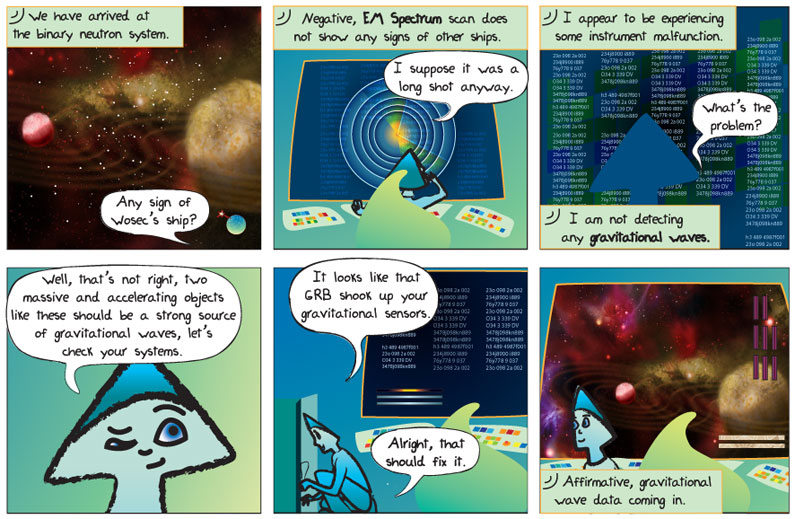
Comic Transcript
Panel 1.
Epo: We have arrived at the binary neutron system.
Alkina: Any sign of Wosec’s ship?
Panel 2.
Epo: Negative, EM Spectrum scan does not show any signs of other ships.
Alkina: I suppose it was a long shot anyway.
Panel 3.
Epo: I appear to be experiencing some instrument malfunction.
Alkina: What’s the problem?
Epo: I am not detecting any gravitational waves.
Panel 4.
Alkina: Well, that’s not right, two massive and accelerating objects like these should be a strong source of gravitational waves, let’s check your systems.
Panel 5.
Alkina: It looks like that GRB shook up your gravitational sensors.
[A few moments laters.]
Alkina: Alright, that should fix it.
Panel 6.
Epo: Affirmative, gravitational wave data coming in.
What does it mean?
Electromagnetic (EM) Spectrum – This is the continuum of waves of light, which range from very low frequency and low energy radio waves to very high frequency and high energy gamma rays. The kind of light we are familiar with is visible light, which is a tiny sliver of the EM spectrum.
Gravitational waves – Just as light is a wave that ripples through electric and magnetic fields, gravitational waves ripple through space-time itself. Scientists expect that these waves also travel at the speed of light. They are generated when massive objects in space accelerate in an asymmetric manner.
In human speak please!
You’ve probably heard of the “speed of sound” or the “speed of light”, but what is the “speed of gravity?”
If you read the last few episodes, you should be familiar with the concept of look-back time. We have discussed how astronomers see objects in the sky as they were at the time their light was emitted, not as they are at the time their light is detected. Just as the light from an object takes a certain amount of time to travel to us across the Universe, so too does the gravity from an object. Scientists expect that gravitational waves also travel at the speed of light, and that they carry information about the objects that emit them.
Gravitational waves were originally predicted by Albert Einstein in his
1916 theory of general relativity, And were discovered in 2015 by the Laser Interferometer Gravitational-wave Observatory (LIGO). For the most part, everything we know about the Universe is based on our observations of the various kinds of light, and light is a wave of electromagnetic fields that travel through space. By contrast, gravitational waves are waves of gravitational fields; they are ripples in space-time itself.
LIGO has now been joined by Virgo (Europe) and KAGRA (Japan), in searches for gravitational waves from some of the most violent events in the Universe. These include binary star systems with two orbiting neutron stars or black holes. Since the initial discovery, a new field of gravitational wave astronomy has begun, allowing us to see the Universe without having to rely on light.
Is that all?
LIGO Scientific Collaboration – An introduction to LIGO and gravitational waves.
LIGO students. – LIGO’s webpage for students.
Multimedia? Yep, we’ve got it right here!
A short video about LIGO, which explains gravitational waves and how LIGO might be able to detect them. Source: http://ligo.org
